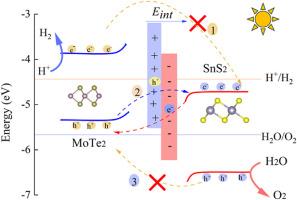Efficient photocatalyst for overall water-splitting hydrogen generation using a direct Z-scheme MoTe2/SnS2 van der Waals heterostructure
IF 3
Q2 PHYSICS, CONDENSED MATTER
引用次数: 0
Abstract
In order to solve the problems of environmental pollution and energy crisis, searching an efficient photocatalyst is very important to transfer the solar energy to hydrogen energy. The MoTe2/SnS2 heterojunction is constructed in this paper and the structural, electronic, optical and photocatalytic properties are investigated by first-principles calculation. The small lattice mismatch of 3.31 % makes it experimental fabricable. The thermodynamics and thermal stabilities are verified from the binding energy and AIMD simulation. A 0.149 |e| Bader charge is transferred from MoTe2 side to SnS2 side and thus a built-in electric field is formed with direction from MoTe2 side to SnS2 side as well as an electrostatic potential drop of 6.48 eV of the MoTe2 layer than the SnS2 layer. Three actions of the built-in electric field, the band bending and smaller band gap of 0.66 eV than 1.66 eV and 2.36 eV for MoTe2 and SnS2 layers respectively make the photogenerated carriers transfer through a direct Z-scheme mechanism. The photogenerated electrons are accumulated on the MoTe2 CB and the photogenerated holes on the SnS2 VB both with strong overpotentials to participate HER and OER and to generate H2 and O2 respectively. The broader and stronger optical absorption, higher STH efficiency of 29.13 %, and the stronger catalytic activity under acidic, neutral and weak alkaline conditions confirm the potential application of the MoTe2/SnS2 heterostructure in photocatalytic overall water-splitting.

采用直接z型MoTe2/SnS2范德华异质结构的高效全水裂解制氢光催化剂
为了解决环境污染和能源危机问题,寻找一种高效的光催化剂是将太阳能转化为氢能的重要途径。本文构建了MoTe2/SnS2异质结,并通过第一性原理计算研究了其结构、电子、光学和光催化性能。3.31%的小晶格失配使其具有可实验性。通过结合能和AIMD模拟验证了其热力学和热稳定性。一个0.149 b|的Bader电荷从MoTe2侧转移到SnS2侧,从而形成一个从MoTe2侧向SnS2侧方向的内置电场,并且MoTe2层的静电电位比SnS2层低6.48 eV。MoTe2层和SnS2层的内建电场、带弯曲和带隙(0.66 eV)分别小于1.66 eV和2.36 eV,三种作用使光生载流子通过直接Z-scheme机制转移。光生电子以强过电位聚集在MoTe2 CB和SnS2 VB上的光生空穴上,分别参与HER和OER,生成H2和O2。MoTe2/SnS2异质结构的光吸收范围更广,光吸收效率更高,达到29.13%,在酸性、中性和弱碱性(pH<9)条件下具有更强的催化活性,证实了MoTe2/SnS2异质结构在光催化整体水分解中的潜在应用。
本文章由计算机程序翻译,如有差异,请以英文原文为准。
求助全文
约1分钟内获得全文
求助全文

 求助内容:
求助内容: 应助结果提醒方式:
应助结果提醒方式:


